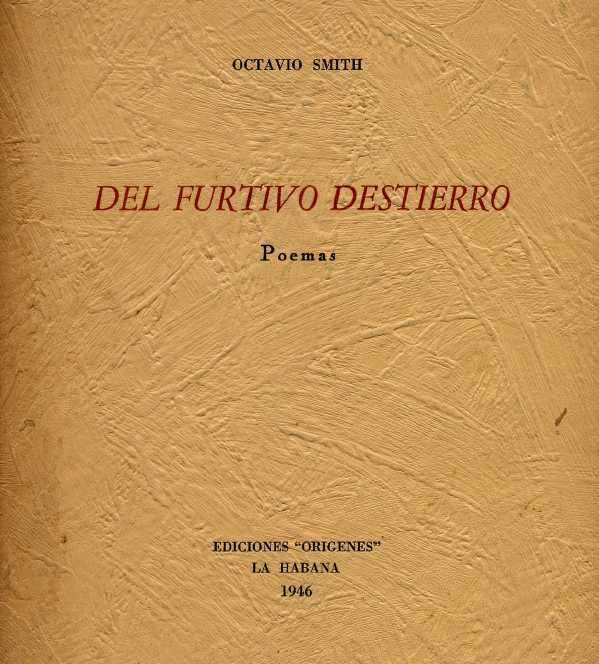4.1.2.8.2 “Of furtive exile”, 1947, by Octavio Smith (1921 – 1987)

“Del furtivo destierro” was published by Octavio Smith under the label “Orígenes” in 1947. It is a work of sober aesthetics, in which traditional Castilian forms, such as the sonnet, converge with stanzas of tight free verse, without any substantial differences being appreciated between the two, since Smith’s lyricism adheres naturally to various rhythmic molds.
Many critics and literary scholars have considered Smith’s poetry, “Of the Scattered Lineage” and “The Sea House,” to be his masterpieces and anthological pieces of our tradition. The first of these poems, among several possible readings, alludes to a pre-creation atmosphere, the swarming of creatures in the divine mind, from the plane of the made universe in which Smith is inserted:
“My heart trembles, far away they wind
this flickering that entangles him,
time shines through or the unruly sand
of music at the back of the days.
Or is it the dynastic ritual of pollen?
for the harp of revived air.
(…)
Everything trembles and alludes to the presentiment
zephyr that imprisons
roses in coral unhinged.
It increases in progressives
thin delirious forms,
“Every creature trembles and urges God.”
In this regard, Fina García Marruz expressed: “But we cannot help but pause, gently amazed, before the beauty of this pulsation “that redeems the confines of the world”, of this trembling of the heart and of the earth, which is like an immense prayer, like the prayer and the physical canticle of Creation, alluding endlessly to the mysterious threshold of God, urging it like a flame that grows “in progressive delirious forms”, a mystical delirium of the pressed and pressing matter.”
In “Casa Marina,” the author captures, through a broad aesthetic lens, the meaning of the sea, a swell that the verses seem to communicate, as the origin of life and a paradisiacal realm from which another expulsion has materialized. In a certain way, the house he alludes to is alien to the passage of time, even atopic, an abstraction that nevertheless does not abandon the blue reference of the sea, whose equal waters are ultimately one and the same water on the ideal plane.
The poet does not renounce a realm of the mythical that is broader than Catholic and specifically biblical references; moreover, despite the austerity in the sense of physical delight commonly attributed to his poiesis, women appear evoked in many of his pieces, from “Stanzas for Sleeping Beauty,” where the myth is recreated with a timeless tone, and in “For the Destroyed Girl,” which seems to allude to the cliché of “fallen women” under the weight of a social morality that had not changed much since the nineteenth century.
One of the most poetically inspired texts in the collection, and less well-known than its two anthological pieces, is “The Visited Coast.” In this piece, woman rises in her symbolism of flesh and spirit, drawing Smith toward a delirious lyricism, sublimating the ancestral desires that were sometimes plucked by the strings of created physical beauty:
“A woman like the night:
distant, flickering and wet,
clear labyrinth of refinement.
A woman, her earth shaped
fragrant with hyaline secrets converging,
knotted knotting the thread that everything
proceed softly and stealthily, the sacred,
silver living conduit in the night.
A woman and the halo with which she delivers
the fervent fabric in which to hover
as an accomplished indelible defector.
A woman allied to the stars
of slow, untethered gleam
and yet immersed, absorbed mediator,
smooth and dark vineyard to place
the duration, the flowing pace
of the fabric that one tree and another tree
when stating it they do not possess.
A woman stretches
reap my gestures or collect
my delirium in its stable,
secret fruity air, embodied,
fine summer system on edge burning
without shores.
A woman gives me hers at length,
as the land zone to the appraised
root, a transient
domain of flaming eternity,
blind bath curl in the chord
busy and impetuous.
The crystalline incandescence
of being and entering into the forbidden
My name and my surroundings have been destroyed.
A woman always gives back,
by degrees of receding high tide
endlessly from my flesh, step by step
taking away miraculous substance,
to the lethal coast with the night
crowd of absences, the onslaught
of the sidereal echo that moves.”








